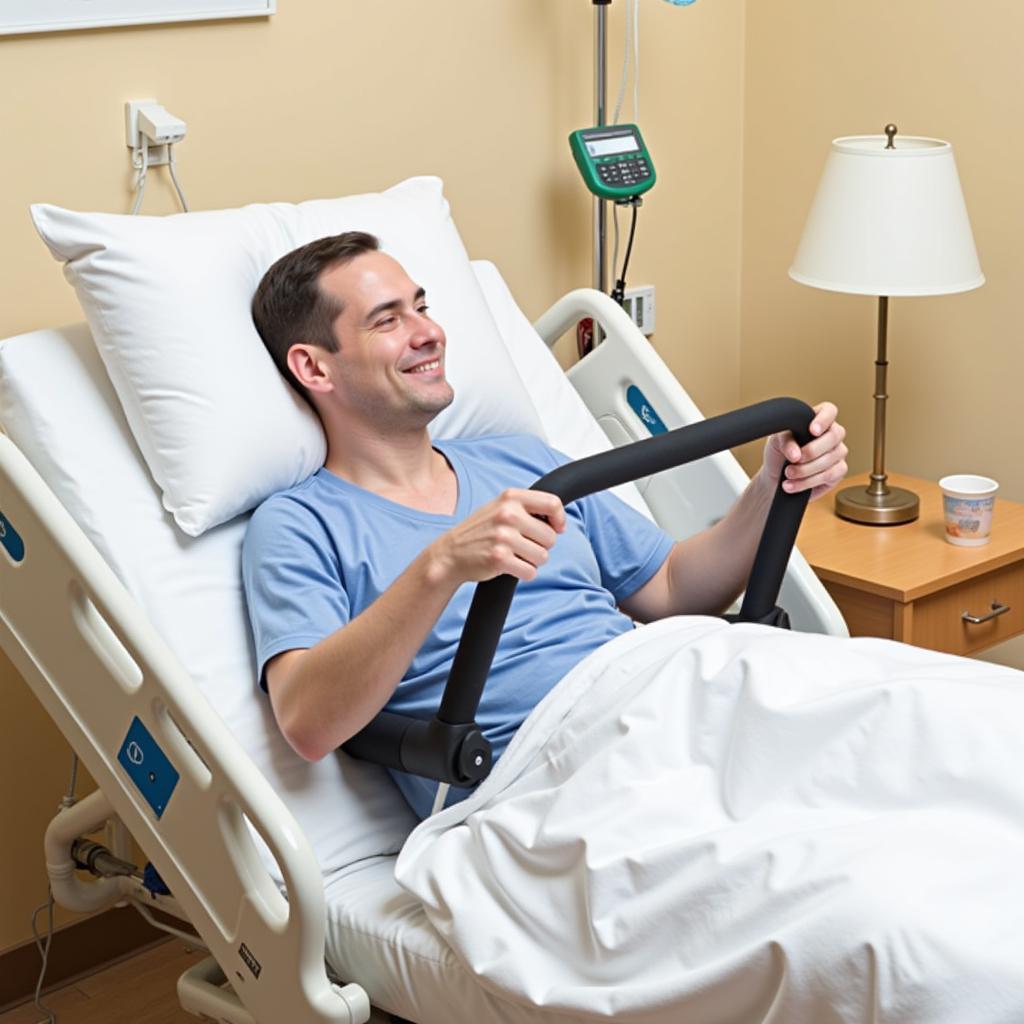A Trapeze Bar For Hospital Bed is a valuable tool that promotes patient independence and reduces strain on caregivers. It provides a secure and stable support system, allowing patients to reposition themselves, sit up, and transfer in and out of bed with greater ease. Whether for short-term rehabilitation or long-term care, understanding the benefits and proper usage of a trapeze bar can significantly enhance the patient experience. Let’s delve deeper into this essential hospital bed accessory.
Understanding the Trapeze Bar’s Role in Patient Care
Trapeze bars offer a multitude of benefits for patients, enhancing both their physical and psychological well-being during their hospital stay. They are particularly beneficial for individuals recovering from surgery, suffering from mobility impairments, or experiencing weakness. By providing a means of self-adjustment, trapeze bars empower patients and foster a sense of control over their environment. This can be especially important during a time when they may feel vulnerable and dependent on others.
Beyond improving mobility, a trapeze bar can also aid in respiratory function by facilitating deeper breathing and coughing. This can be crucial for patients with respiratory conditions or those recovering from surgery where deep breathing is essential for preventing complications.
How a Trapeze Bar Improves Patient Independence
The trapeze bar, an often-overlooked tool, can drastically improve a patient’s independence. By offering a sturdy support, patients can adjust their position in bed without assistance, reducing the burden on caregivers and fostering a sense of self-reliance. This simple device can transform the hospital experience from one of dependence to one of empowerment.
Selecting and Installing the Right Trapeze Bar
Choosing the correct trapeze bar and ensuring its proper installation is critical for patient safety and comfort. Trapeze bars are designed to be compatible with most standard hospital beds, however, it’s always advisable to verify compatibility before purchasing. Consult with a healthcare professional or equipment supplier to determine the most suitable trapeze bar for the specific needs of the patient.
Ensuring Proper Installation and Safe Usage
Once you have selected the appropriate trapeze bar, proper installation is paramount. Ensure the bar is securely attached to the hospital bed frame and can withstand the patient’s weight. The height should be adjusted to allow for comfortable and safe usage. A healthcare professional should provide guidance on the correct height and positioning of the bar to maximize its benefits and minimize the risk of injury.
Trapeze Bar Exercises and Techniques
Beyond simply assisting with repositioning, the trapeze bar can be incorporated into therapeutic exercises to strengthen upper body muscles and improve overall mobility. These exercises should be performed under the supervision of a physical therapist or healthcare professional.
renting a hospital bed for home
Building Strength and Promoting Recovery
Simple exercises like pulling up to a seated position, performing assisted range of motion exercises, or even just hanging from the bar for short periods can significantly improve upper body strength and promote recovery. These exercises are especially helpful for patients regaining strength after surgery or illness.
“Trapeze bars are a simple yet powerful tool in patient recovery,” says Dr. Amelia Carter, a leading physical therapist. “They not only aid in mobility but also empower patients to actively participate in their rehabilitation process.”
Caring for Your Trapeze Bar
Regular cleaning and maintenance are crucial for ensuring the longevity and hygiene of the trapeze bar. Wipe down the bar regularly with a disinfectant solution and check for any signs of wear and tear.
Maintaining Hygiene and Functionality
“Proper maintenance ensures the trapeze bar remains a valuable asset in patient care,” states Dr. Samuel Jones, a renowned expert in rehabilitation medicine. “Regular cleaning and inspection will prevent the spread of germs and maintain the bar’s functionality.”
Frequently Asked Questions About Trapeze Bars
Here are answers to common queries about trapeze bars:
-
How much weight can a trapeze bar hold? Weight capacity varies depending on the model, typically ranging from 250-400 pounds. Always check the manufacturer’s specifications.
-
Can a trapeze bar be used at home? Yes, trapeze bars can be installed on home hospital beds.
-
Who benefits from using a trapeze bar? Patients recovering from surgery, those with limited mobility, and individuals with weakened upper body strength.
-
Are there different types of trapeze bars? Yes, there are various designs, including those with padded grips or adjustable heights.
-
How do I clean a trapeze bar? Regularly wipe it down with a disinfectant solution suitable for medical equipment.
-
Does insurance cover the cost of a trapeze bar? In some cases, insurance may cover the cost if deemed medically necessary. Consult with your insurance provider.
-
Where can I purchase a trapeze bar? Medical supply stores, pharmacies, and online retailers.
Conclusion
The trapeze bar for hospital bed is a valuable tool for enhancing patient comfort, independence, and recovery. From facilitating movement and promoting strength building to reducing strain on caregivers, its benefits are multifaceted. By understanding the features, proper usage, and maintenance of a trapeze bar, patients and caregivers alike can maximize its positive impact throughout the recovery process.
 Patient using a trapeze bar to improve mobility and comfort in a hospital bed.
Patient using a trapeze bar to improve mobility and comfort in a hospital bed.
When you need support, please contact Phone Number: 02437655121, Email: [email protected] Or visit the address: 298 Cau Dien Street, Minh Khai, Bac Tu Liem, Hanoi, Vietnam. We have a 24/7 customer service team.